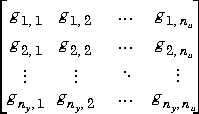

| Model Predictive Control Toolbox |   |
tfd2mod converts a transfer function (continuous or discrete) from the MPC tf format into the MPC mod format, converting to discrete time if necessary.
Syntax
Description
Consider a transfer function such as

The MPC tf format is a matrix consisting of three rows:
The tf matrix will always have at least two columns, since that is the minimum width of the third row.
The input arguments for tfd2mod are:
delt2
The sampling period for the system. If any of the transfer functions g1, ..., gN are continuous-time or discrete-time with sampling period not equal to delt2, tfd2mod will convert them to discrete-time with this sampling period.
ny
The number of output variables in the plant you are modeling.
g1, g2,...gN
A sequence of N transfer functions in the tf format described above, where N  1. These are assumed to be the individual elements of a transfer-function matrix:
1. These are assumed to be the individual elements of a transfer-function matrix:

Thus it should be clear that N must be an integer multiple (nu) of the number of outputs, ny.
Also, tfd2mod assumes that you are supplying the transfer functions in a column-wise order. In other words, you should first give the ny transfer functions for input 1 (g1,1 to gny, 1), then the ny transfer functions for input 2 (g1,2 to gny, 2), etc.
tfd2mod converts the transfer functions to discrete-time, if necessary, and combines them to form the output variable, model, which is a composite system in the MPC mod form.
Example
Consider the linear system:

The following commands build separate models of the response to the manipulated variables, u, and the unmeasured disturbance, w, all for a sampling period T = 3 then combines them using addumd to get a model of the entire system (the pmod variable):
g11=poly2tfd(12.8,[16.7 1],0,1); g21=poly2tfd(6.6,[10.9 1],0,7); g12=poly2tfd(-18.9,[21.0 1],0,3); g22=poly2tfd(-19.4,[14.4 1],0,3); delt=3; ny=2; umod=tfd2mod(delt,ny,g11,g21,g12,g22); gw1=poly2tfd(3.8,[14.9 1],0,8); gw2=poly2tfd(4.9,[13.2 1],0,3); wmod=tfd2mod(delt,ny,gw1,gw2); pmod=addumd(umod,wmod);
Restriction
The current limit on the number of input transfer functions is N = 25.
See Also
mod, poly2tfd, tfd2step
 | svdfrsp | tfd2step |  |